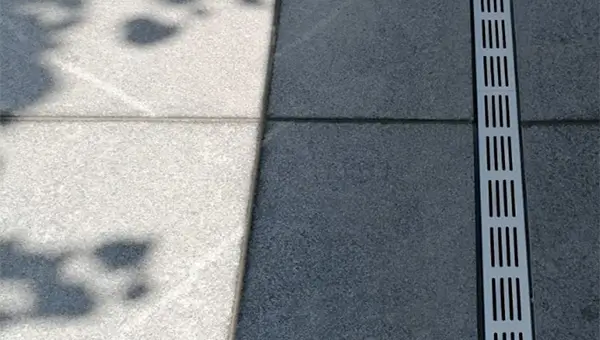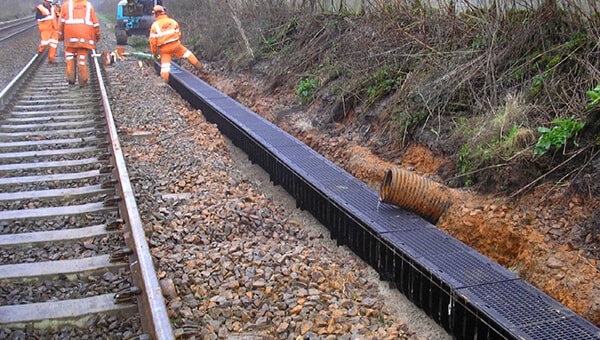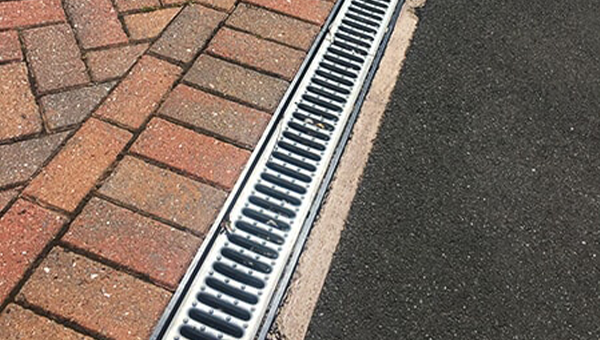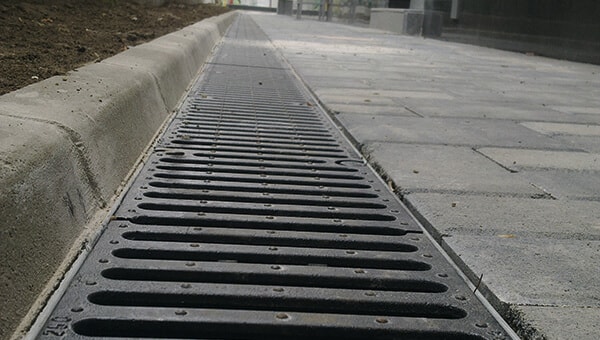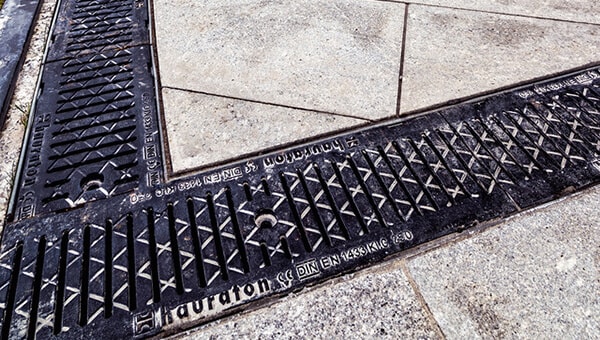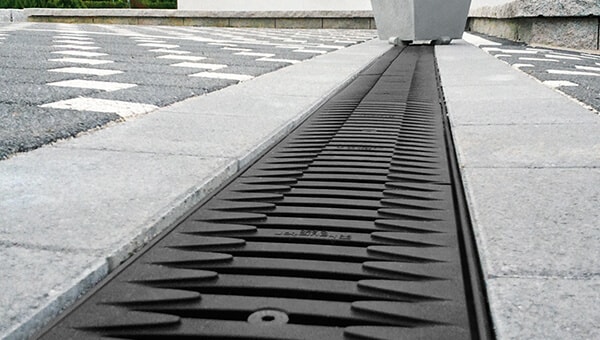
Linear channel drainage systems are a versatile and effective solution for managing surface water runoff in a variety of applications, from residential driveways to commercial parking lots to industrial facilities. When choosing a channel drain system for your project, there are a number of important factors to consider.
Arguably, the most important consideration when choosing channel drainage is the load-bearing capacity required for your intended application.
Channel Drain Load Bearing
The load-bearing capacity of a channel drain refers to the amount of weight it can safely support without failure. This is an important consideration, especially for areas with high traffic volumes or heavy vehicles. Channel drains are classified into different load classes, with A15 being the lightest and F900 being the heaviest.
To determine the appropriate load class for your project, consider the following factors:
- The type of traffic that will be using the area.
- The weight of any vehicles or equipment that will be passing over the drain.
- The frequency of traffic.
The heavier the vehicle and the higher the traffic frequency, the stronger the channel drain being used will need to be.
For example, a channel drain in a residential driveway will have a lower frequency of traffic than in a commercial car park and, therefore, can have a lower load-bearing capacity. A channel drain in an industrial facility, however, will have heavier vehicles passing over it than in a residential area and, therefore, need to have a much higher load-bearing capacity.
For more detailed information on this, check out our “Choosing the right loading for your channel drain application" article.
But aside from this obvious consideration, what other things do you need to think about when buying channel drainage? We intend to answer that very question in this article. Here are 7 things you should consider in order to ensure you select the most suitable channel drainage products for your project.
1. Drainage requirement of a channel drain system
The drainage requirements of your project will determine the size and capacity of the channel drain system you need. It's important to select a channel drain with the appropriate dimensions and capacity to handle the expected water load.
Consider the following factors when determining the drainage requirements of your project:
- The size and slope of the area to be drained.
- The expected volume of water.
- The flow rate.
If the channel drain is intended to drain a large area or a high volume of water, you will need to choose a system with a higher capacity. You also need to consider the slope of the area to be drained, as this will affect the flow rate of the water.
If you are unsure of the drainage requirements for your project, it is best to consult with a drainage professional.
2. Long-term performance of a channel drain system
When choosing a channel drain, it's important to consider the long-term performance of the drain. Some materials are more durable than others. It's important to choose a drain that will last for many years to come.
Consider the following factors when evaluating the long-term performance of a channel drain:
- The durability of the material.
- The warranty offered by the manufacturer.
- The reputation of the manufacturer.
Look for a system that is made from high-quality materials and backed by a strong warranty. It’s always worth checking out the manufacturer’s own website for these kinds of details. It's also important to buy your channel drain from a reputable supplier. This will help ensure that you are getting a high-quality product.
3. Aesthetic appeal of a channel drain system
A channel drain's aesthetic appeal may be a low priority for some projects, but it's still worth considering, especially for areas where appearances matter. Channel drains come in a variety of designs and materials, so you should be able to find a system that complements the overall look of your project.
Consider the following factors when selecting a channel drain for aesthetic reasons:
- The design of the channel drain.
- The material of the channel drain.
- The surrounding landscape.
For example, if you have a modern home, you may want to choose a channel drain with a sleek, contemporary design. If you have a traditional home, you may want to choose a channel drain with a more classic design. If you have a paved driveway, you may want to choose a slot channel drain system to avoid breaking up the pattern of the paving blocks too much.
4. Installation ease of a channel drain system
Channel drain systems can be installed by DIY homeowners or by professional contractors. The complexity of the installation will depend on the size and complexity of the system, as well as the ground conditions.
If you are a DIY homeowner, it is important to choose a channel drain system that is easy to install. You should also consider your skill level and available resources before attempting to install a channel drain system yourself.
Consider the following factors when evaluating the installation ease of a channel drain:
- The complexity of the installation process – including connection to a suitable drainage pipe system.
- The tools and equipment required for installation.
- The need for professional expertise.
For example, installing plastic channel drainage for your patio should be fairly simple in most cases. Installing heavy concrete channel drainage in an already paved driveway, however, is likely to be more difficult and require a bit more experience.
Check out our “How to install a channel drainage system” guide to get a better understanding of what is involved. If you are not comfortable installing a channel drain yourself, though, we’d recommend hiring a professional contractor to do it for you.
5. Maintenance needs of a channel drain system
Channel drains require regular maintenance to keep them functioning properly. The level of maintenance required will vary depending on the type of channel drain and the environment in which it is installed.
Consider the following factors when evaluating the maintenance needs of a channel drain:
- The type of channel drain.
- The environment in which it is installed.
- The frequency of use.
- The level of maintenance you are willing and able to perform.
For example, a channel drain in a residential driveway will require less maintenance than a channel drain in a commercial parking lot. Similarly, a channel drain in an industrial facility will require more maintenance than a drain in a residential area.
Here are some general maintenance tips for channel drains:
- Inspect the channel drain regularly for any signs of damage or clogging.
- Clean the channel drain and grating regularly to remove debris.
- Flush the channel drain with water to remove any sediment that may have accumulated.
- Repair or replace any damaged components immediately.
Check out our “How to clean channel drains” guide to get a better idea of what type of maintenance is required.
6. Budget considerations for a channel drain system
Channel drain systems can range in price from under a hundred pounds to several thousand pounds, depending on the size, capacity, material, and features of the system. It is important to determine your budget for the project before you start shopping for a channel drain system.
Consider the following factors when budgeting for a channel drain:
- The size and capacity of the drain.
- The material of the drain.
- The complexity of the installation.
- The need for professional expertise.
When setting your budget for a channel drain system, it is also important to consider the long-term costs of the system, such as the cost of maintenance and repairs.
For the average DIY driveway or patio channel drainage project, Hauraton’s TOP X Galvanised Steel Channel Drain Multipack is a great all-round, cost-effective investment that is quick and simple to install. For larger projects, however, you’ll need to weigh up suitability vs affordability and ensure that you put function over form.
7. Environmental impact of a channel drain system
While it may not be critical for every project, it is still worth thinking about the environmental impact it may have, as some materials used to make channel drains are more environmentally friendly than others.
Consider the following factors when evaluating the environmental impact of a channel drain:
- The sustainability of the material.
- The recyclability of the material.
- The manufacturing process of the material.
Here’s a quick table to help you compare the factors for the typical channel drain materials available:
| Material | Sustainability | Recyclability | Manufacturing Process |
|---|---|---|---|
| Concrete | Sustainable, made from natural materials, and durable. | Not easily recycled, but can be crushed and reused as aggregate. | Simple and energy-efficient |
| Polymer concrete | Less sustainable than traditional concrete, made from petroleum-based products, more durable. | Not easily recycled | Similar to traditional concrete, but requires additional energy and resources |
| Stainless steel | Durable and recyclable, but requires a significant amount of energy and resources to produce | Highly recyclable | Complex and energy-intensive |
| Galvanised steel | More sustainable than traditional steel, as it does not need to be replaced as often | Highly recyclable | Similar to traditional steel, but requires additional energy and resources to apply the zinc coating |
| Fiberglass (Glass reinforced plastic) | Made from non-renewable materials, but can be recycled at the end of its life cycle | Recyclable, but the process is complex and energy-intensive | Relatively simple and energy-efficient |
| Plastic (Polypropylene) | Thermoplastic, can be melted and reused | Highly recyclable | Relatively simple and energy-efficient |
Please Note: these are broad statements made about the typical environmental impact of these materials. Some manufacturers use different blends and combinations of materials with varying production processes that can make certain products more or less environmentally friendly. If the environmental impact of your project is a key consideration for your purchasing decision, we recommend doing further research into the brands you are comparing. Alternatively, you can contact our technical team for professional advice on finding the most suitable channel drain for your project.
By taking all of these factors into account, you should be suitably prepared to choose the right channel drain for your specific needs and ensure that it will perform well for many years to come. This, however, then presents you with two final questions: what material should you choose, and what grating type do you need?
Selecting the right channel drain material
Channel drains are made from a variety of materials, including concrete, polymer concrete, stainless steel, galvanised steel, fibreglass and plastic. Each material has its own advantages and disadvantages, so it's important to choose one that is right for your specific needs:
Plastic and Fibreglass are both lightweight, affordable options for light to medium-duty applications, but typically have a shorter lifespan than other materials and can be more prone to damage.
Stainless and Galvanised Steel offer a modern aesthetic, excellent corrosion resistance, and a long lifespan, but they tend to be more expensive and require more maintenance to preserve their resistant coatings.
Concrete and Polymer Concrete offer exceptional strength, chemical resistance, and durability, making them most suitable for industrial and heavy-duty applications, but they tend to be heavier and can be more expensive than other materials.
The best material for your project will depend on the environmental conditions and the specific requirements of your application.
For example, if the channel drain will be exposed to chemicals or saltwater, you will need to choose a material that is resistant to corrosion. If the channel drain will be in a high-traffic area, you will need to choose a material that is durable and long-lasting. Consider the following factors when selecting a material:
- The environmental conditions where the drain will be installed
- The level of corrosion resistance required
- The desired durability and longevity
- The budget
Selecting the right channel drain grating
Channel drains typically have a grating over the top to prevent debris from entering the drain. Gratings are available in a variety of materials, including cast iron, stainless steel, galvanised steel and plastic. The best material for your project will depend on the same factors as the channel drain material, such as the load class, environmental conditions, budget, and aesthetic considerations.
Consider the following factors when selecting a grating:
- The load class of the grating (should match or exceed the load class of the channel drain body)
- The pedestrian safety requirements
- The debris management requirements
- The aesthetic appeal
For example:
- If the channel drain is to be installed in an area with high volumes of vehicle traffic, you will need to choose a grating that is strong and durable enough to withstand the weight of vehicles and equipment.
- If the channel drain is to be installed in an area with high volumes of pedestrian traffic, you’ll need a grating that is heelsafe to help prevent tripping hazards.
- If the channel drain is to be installed in an area where a lot of debris can be expected, you’ll need a grating with smaller holes to help prevent the channel from becoming clogged.
- If the channel drain is to be installed in an area where heavy water runoff is expected, then a grating with larger holes will be required to prevent flooding.
- If the channel drain is to be installed in an area where aesthetics are important, you may want to choose a decorative grating or use a slot drain to keep the visual impact to a minimum.
Fully understanding the requirements of the installation environment is key to picking the most appropriate grating.
For a deeper dive into both the typical materials and grating types available, check out our “Channel drain materials and gratings explained” article.
And that’s it for our quick guide on the most important things to consider when buying linear channel drainage. If you feel ready to take the next step and purchase your perfect channel drain system, we have a comprehensive range of Hauraton products available for all loading classes over in our Channel Drain section. If, however, you feel that you need a little more guidance on what type of channel drainage to buy, check out our “Choosing the right channel drain for your project” article for some application-specific recommendations.
If you have any other questions about buying channel drainage, contact JDP today. Our team of experts are always on hand to help with all of your civils and drainage needs.


